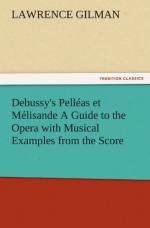the characteristic plain-song progressions to secure,
for special purposes, a particular and definite effect
of color; but no one had ever before deliberately
adopted the Gregorian chant as a substitute for the
modern major and minor scales, with their deep-rooted
and ineradicable harmonic tendencies, their perpetual
suggestion of traditional cadences and resolutions.
To forget the principles underlying three centuries
of harmonic practice and revert to the methods of
the mediaeval church composers, required an extraordinary
degree of imaginative intuition; purposely and consistently
to employ those methods as a foundation upon which
to erect an harmonic structure most richly and elastically
contrived—to vitalize the antique modes
with the accumulated product of modern divination and
accomplishment—was little less than an inspiration.
Debussy must undoubtedly have realized that the familiar
scales, which have so long and so faithfully served
the expressional needs of the modern composer, tend
now to give issue to musical forms that are beginning
to seem clichee: forms too rigidly patterned,
too redolent of outworn formulas—in short,
too completely crystallized. Chopin, Liszt, Wagner,
and after them the modern Germans and their followers,
found in a scale of semitones a limited avenue of
escape from the confinement of the modern diatonic
modes, and bequeathed to contemporary music an inheritance
of ungoverned chromaticism which still clogs its progress
and obstructs its independence. Debussy, through
his appreciation of the living value of the old church
modes, has been enabled to shape for himself a manner
of utterance which derives from none of these influences.
It is anything but chromatic; indeed, one of its most
striking characteristics is its use of whole-tone progressions,
a natural result, of course, of its dependence upon
the old modes. Other contemporary Frenchmen have
made occasional use of Gregorian effects; but Debussy
was the first to adopt them deliberately as the basis
of a settled manner of utterance, and he has employed
them with increasing consistency and devotion.
His example has indubitably served to enrich the expressional
material at the disposal of the modern music-maker—there
cannot conceivably, in reason, be two opinions as to
that: he has acted upon a principle which is,
beyond question, liberating and stimulating.
And the adaptability to his own peculiar temperament
of the wavering and fluid order of discourse which
is permitted by the flexibility and variety of the
antique modes is sufficiently obvious.
His resort to Gregorian principles is, it has been observed, far from being a matter of recent history with him. Almost twenty years ago we find him writing in the spirit of the old modes. Examine the opening phrases of his song, Harmonie du Soir (composed in 1889-1890), and note the felicitous adaptation to modern use of the “authentic” mode known as the Lydian, which corresponds to a C-major




